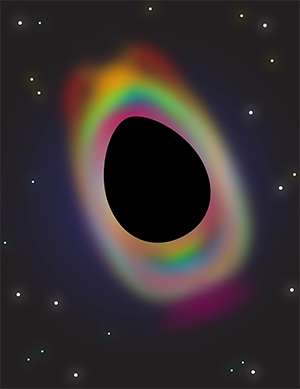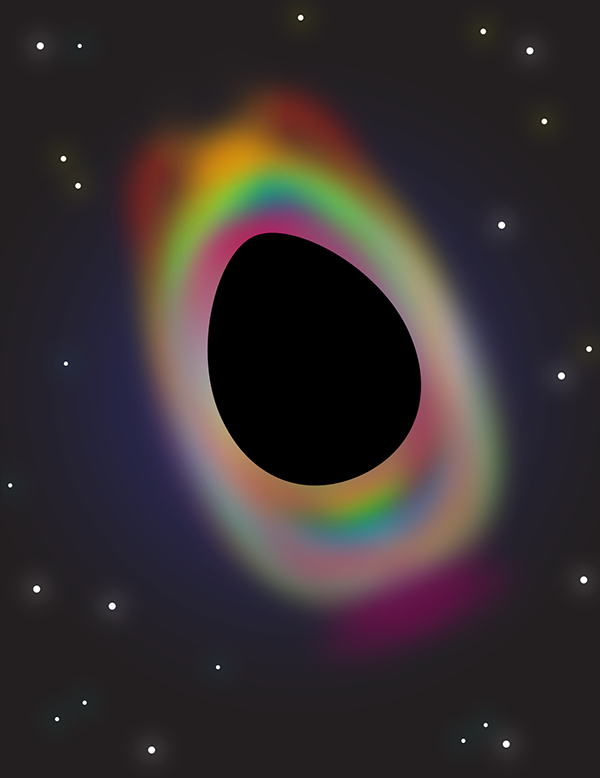The Simplicity of Black Holes
In general relativity, strong gravity can warp the geometry of spacetime so much that black holes are formed—regions from which not even light can escape. The interior of a black hole, where curvature becomes infinite, is an extremely complex configuration that defies our current theories. But according to general relativity, these complexities might be hidden to observers outside the black hole’s horizon. The so-called “no-hair theorem” implies that isolated black holes in equilibrium are, in fact, extraordinarily simple [1] and can be fully characterized by just two numbers, the mass ( ) and the angular momentum ( ). As physicist John Wheeler put it, “black holes have no hair”—a statement that uses hair as a metaphor for all complicated details.
However, this simplicity emerges only if the black hole is isolated from everything else—an assumption not met in most astrophysical scenarios. Norman Gürlebeck of the Center of Applied Space Technology and Microgravity (ZARM) at the University of Bremen, Germany, has now unraveled a new aspect of black hole simplicity. He has shown that, under certain assumptions, the no-hair theorem is still valid when the black hole is not isolated [2]. The extended theorem would, for instance, apply when a black hole is surrounded by a matter disk (see Fig. 1).
The new work considers black holes that are static: they neither accrete mass nor rotate. If they are isolated, their gravitational field is spherical and is characterized entirely by the black hole’s mass . But in realistic environments, black holes can be distorted by the mass surrounding them. Mass distortions can be described by a sum of multipole moments, similar to the ones used in electromagnetism to calculate the electric field outside a region containing charges. In classical Newtonian gravity, if a star is spherical, only its monopole moment is nonzero and is given by its mass. But if the star is distorted, its higher multipoles are also nonzero. The Poisson equation relates the “source moments” (multipoles of the given mass distribution) to the “field moments” (obtained by expanding the Newtonian potential in powers of ), which completely determine the gravitational field outside the source. Thanks to the linearity of the Poisson equation, the source multipoles are the same as the field multipoles.
A similar idea applies to objects like black holes that must be described by general relativity. In 1970, Robert Geroch [3] introduced analogous field moments for static mass configurations, which were later shown to be sufficient to determine the spacetime geometry outside the region containing the sources [4]. Within this multipole formalism, the no-hair result can be rephrased to say that only the mass monopole is needed to define the external spacetime geometry of an isolated static black hole.
But for a black hole surrounded, say, by matter rings, this simplicity is lost and the black hole acquires two types of “hair.” First, multipoles beyond the mass monopole are needed to describe the spacetime geometry outside the black hole. Second, the presence of external matter also distorts the geometry of the black hole horizon. These distortions can also be fully characterized by a set of so-called horizon multipoles [5], which are the analogs of the source multipoles in Newtonian gravity. They represent hair on the surface of the black hole, created by the mere presence of outside matter. Geroch’s field multipoles, on the other hand, are the hair that a distant observer sees.
But unlike Newtonian gravity, general relativity is governed by equations that are highly nonlinear. As a result, the gravitational field at infinity is more than the sum of the field generated by the individual parts. Instead, this field includes contributions from the black hole and the matter rings, plus a third contribution from the very gravitational field they create. So far, theorists have not been able to cleanly disentangle the three. As a result, no simple relation exists between the horizon moments (the intrinsic black hole’s hair) and the field moments (the hair seen by an external observer).
However, as Hermann Weyl pointed out almost a century ago [6], a key simplification occurs if one assumes that the entire system is not only static but also axisymmetric, i.e., symmetric under rotations around the axis. In this case, one can bypass the nonlinearities of general relativity thanks to a transformation that leads to an equivalent system whose governing equations are linear. In 2014, Gürlebeck [7] showed an important consequence of this reformulation. If there is no matter in the immediate vicinity of the black hole horizon, the field multipoles defined at infinity can be split cleanly into two parts: a black hole contribution (given by an integral over a surface just outside the horizon) and a matter contribution (given by a volume integral over matter rings). This crucially eliminates the third contribution to the field multipoles, the one from the gravitational field itself. In effect, Weyl’s strategy leads to a “renormalization,” where this contribution is absorbed into the first two. As a result, the multipoles assigned to the black hole by this procedure do not match the intrinsic, source multipoles that characterize the horizon geometry; the intrinsic multipoles get “dressed.”
Gürlebeck ‘s new observation [2] builds on these results to show that this dressing has a dramatic consequence. It wipes out all the higher-order horizon multipoles from the black hole contribution, leaving only the monopole. Thus, even if the horizon is highly distorted by external matter rings, in the Gürlebeck decomposition, the black hole contributes only to the mass monopole and not to any of the hair seen at infinity. As long as the entire system is static and axisymmetric, hair seen by a distant observer is entirely due to matter.
This result suggests interesting directions for future research. On the theoretical side, the challenge is to understand the physics behind this mathematical derivation. How does the effective linearity, induced by axisymmetry, manage to hide all the horizon hair from a distant observer? Another key question is whether the results can be extended to the more general case of rotating black holes. While the fact that Gürlebeck’s analysis [7] was carried out using methods applicable to rotating black holes is encouraging, it is far from obvious that the no-hair theorem will again admit a simple generalization. The new extension of the theorem may also bear consequences on observations, since it is now applicable to more realistic astrophysics situations in which matter rings surround a black hole. Since no-hair theorems do not necessarily hold in alternative theories of gravity, observational tests can help constrain the alternatives and test general relativity (see, e.g., Ref. [8]).
This research is published in Physical Review Letters.
References
- M. Heusler, Black Hole Uniqueness Theorems (Cambridge University Press, Cambridge, 1996)[Amazon][WorldCat]
- Norman Gürlebeck, “No-Hair Theorem for Black Holes in Astrophysical Environments,” Phys. Rev. Lett. 114, 151102 (2015)
- R. Geroch, “Multipole Moments II. Curved Space,” J. Math. Phys. 11 2580 (1970)
- R. Beig and W. Simon, “Proof of a Multipole Conjucture due to Geroch,” Commun. Math. Phys. 78, 75 (1980)
- A. Ashtekar, J. Engle, T. Pawlowski, and C. van den Broeck, “Multipole Moments of Isolated Horizons,” Class. Quant. Grav. 21, 2549 (2004)
- H. Weyl, “Zur Gravitationstheorie,” Ann. Phys. 359, 117 (1917)
- N. Gürlebeck, “Source Integrals for Multipole Moments in Static and Axially Symmetric Spacetimes,” Phys. Rev. D 90, 024041 (2014)
- T. Johannsen, “X-ray Probes of Black Hole Accretion Disks for Testing the No-Hair Theorem,” Phys. Rev. D 90, 064002 (2014)





